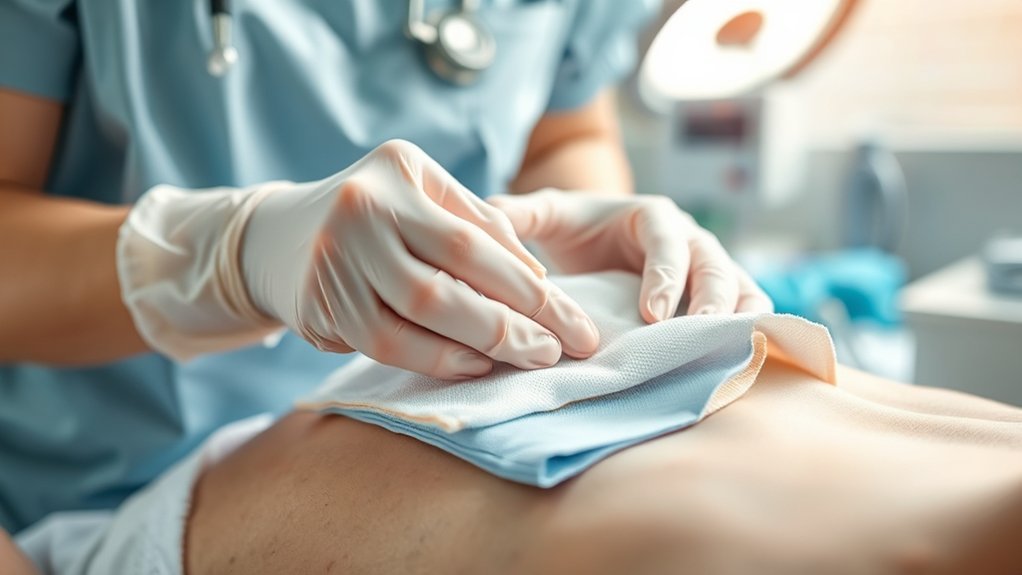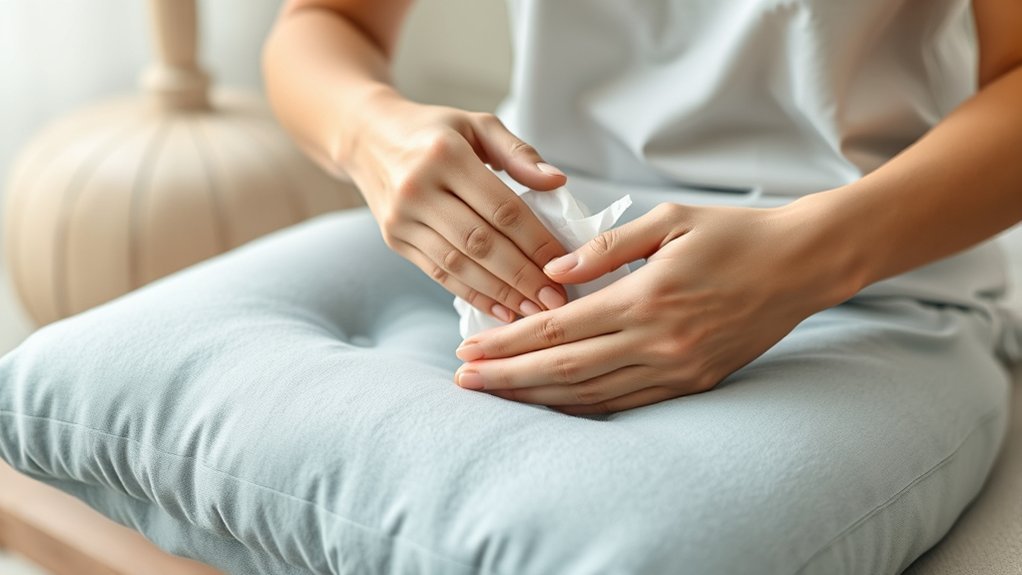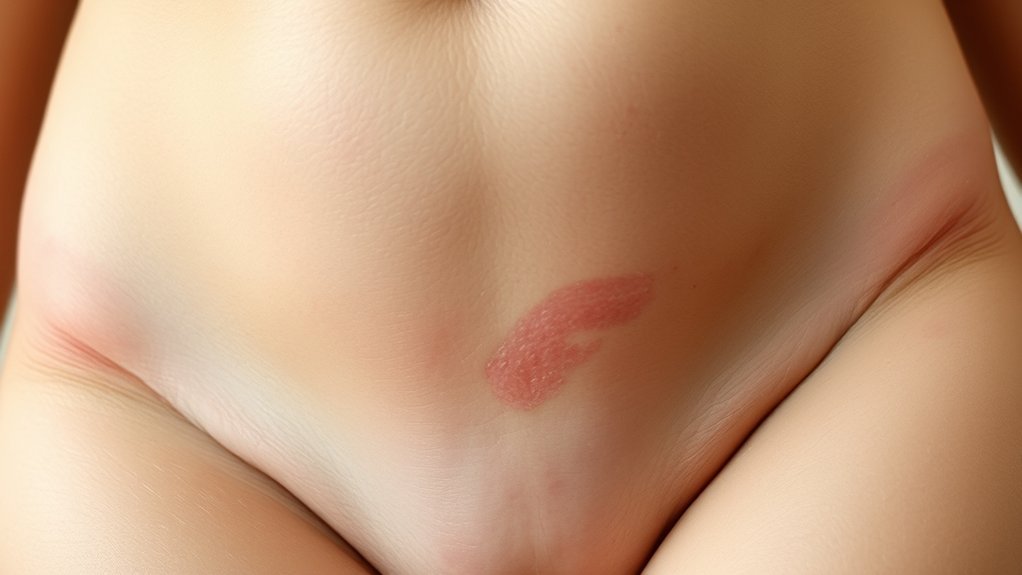Just as a gardener tends to delicate blooms, your perineal care is essential for a smooth postpartum recovery. After childbirth, it’s important to monitor specific symptoms that could signal complications. Recognizing the signs early can make a significant difference in your healing process. So, what should you watch for as you navigate this key phase?
Understanding Perineal Care After Childbirth
Understanding perineal care after childbirth is essential for your recovery, especially if you’ve experienced tears or an episiotomy. Proper perineal care promotes healing and helps prevent infection during your postpartum care.
Rinse the perineal area with warm water after using the bathroom and gently pat it dry; avoid soaps or bubble baths that could cause irritation. To alleviate pain or discomfort, consider using cold compresses, postpartum cooling pads, or witch hazel pads, which can reduce swelling.
Maintaining a high-fiber diet and staying hydrated is vital to prevent constipation, which can strain the perineum and hinder your healing process. For additional support, consider doula-led prenatal education classes to empower your recovery and enhance your postpartum experience.
Always consult your healthcare provider if you notice any signs of infection, such as increased pain or unusual discharge.
Common Symptoms to Monitor
As you recover, it’s essential to monitor for signs of infection, such as increased pain, swelling, or unusual discharge.
Keep an eye on any persistent or worsening pain, as normal discomfort should lessen over time.
Additionally, report a fever above 100.4°F, which may signal the need for medical attention. It’s also important to understand how consumer protection in healthcare can provide you with resources and support during your recovery.
Infection Warning Signs
Recognizing the signs of infection is essential for anyone recovering postpartum. Keep an eye out for any of the following symptoms, as they may require you to contact your healthcare provider.
| Symptom | Description | Action Required |
|---|---|---|
| Fever | Temperature above 100.4°F | Report immediately |
| Persistent Pain | Increased pain, swelling, or redness | Seek medical evaluation |
| Unusual Discharge | Foul-smelling or pus-filled discharge | Contact your healthcare provider |
| Clammy Skin & Chills | Signs of possible sepsis | Immediate care is essential |
| Painful Urination | Severe abdominal pain or painful urination | Prompt evaluation needed |
Stay vigilant; early detection can lead to effective treatment and a smoother recovery.
Pain and Discomfort
After addressing infection warning signs, it’s important to monitor pain and discomfort in the perineal area following childbirth. Experiencing pain is common, especially if you’ve had an episiotomy or a perineal tear, and it may last for several weeks.
Afterpains, which feel like menstrual cramps, can also occur as your uterus contracts to reduce bleeding. Keep an eye out for symptoms like increased pain, swelling, or unusual discharge, as these may indicate infection and require prompt medical consultation.
Vaginal discharge typically starts bright red and evolves to darker shades before becoming yellow or white over 4-6 weeks; any return to bright red bleeding should be evaluated.
Persistent or worsening pain shouldn’t be ignored, so maintain open communication with your healthcare provider.
Signs of Infection in the Perineal Area
How can you tell if there’s an infection in the perineal area? Look for signs like increased pain, swelling, and redness, especially following a tear.
If you notice purulent or foul-smelling discharge, it’s essential to consult a healthcare professional. A fever above 100.4°F can also indicate an infection, particularly if you’re experiencing other symptoms.
Persistent pain that worsens over time rather than improving may signal an underlying infection or complication.
Additionally, keep an eye out for red streaks or lumps in the breasts, as these could suggest mastitis, a breastfeeding-related infection.
Pain Management Strategies
When managing pain in the perineal area, utilizing effective strategies can greatly enhance your comfort during recovery.
Over-the-counter pain relievers like acetaminophen or ibuprofen are safe for breastfeeding and can help relieve pain after an episiotomy or perineal tear.
Applying an ice pack to the perineum offers immediate relief while reducing swelling—just remember not to let it touch your skin directly.
Warm baths, or sitz baths, can soothe discomfort and promote healing. Additionally, using warm water spray during urination can ease pain effectively.
Engaging in pelvic floor exercises aids recovery by increasing blood flow to the area and strengthening surrounding muscles, further supporting your pain management strategies.
The Importance of Hygiene

Maintaining proper hygiene in the perineal area is essential for your recovery, especially after childbirth. By following effective cleaning techniques and infection prevention strategies, you can considerably reduce the risk of complications. Regular care not only promotes healing but also enhances your overall comfort during this sensitive time. Additionally, ensuring a smoke-free environment can further aid in your recovery and well-being.
Postpartum Hygiene Practices
Proper hygiene after childbirth is essential for your recovery, especially in the perineal area, which can be particularly susceptible to infection due to tears or episiotomies.
Rinse your perineum with warm water after using the bathroom and gently pat it dry to promote healing and avoid irritation. Change your sanitary pads every four hours to maintain cleanliness and reduce the risk of infection or irritation related to postpartum bleeding.
Daily showering or bathing is advised, using only water for perineal care; avoid soaps and bubble baths that might disrupt your natural balance.
Additionally, keeping the perineum dry and wearing loose-fitting clothing can help prevent moisture buildup, further reducing the risk of infection during your recovery.
Infection Prevention Strategies
Postpartum hygiene practices play an essential role in preventing infections, particularly in the perineal area. You should wash your hands before and after perineal care to promote healing and prevent infection.
Daily showering with warm water—without soaps or bubble baths—minimizes irritation and reduces infection risk. Change your sanitary pads every four hours to avoid moisture buildup, which can lead to irritation and infection.
After each bowel movement, rinse your perineum with warm water and gently pat it dry to maintain cleanliness. Additionally, wearing loose-fitting clothing helps keep the area dry, which is significant for effective infection prevention strategies during your healing process.
Prioritizing these hygiene practices is critical for a healthy recovery.
Proper Cleaning Techniques
Effective cleaning techniques are essential for ensuring hygiene after childbirth, particularly in the sensitive perineal area. Proper hygiene is vital for infection prevention and to support the healing process.
Here are some recommended practices:
- Rinse the perineal area with warm water after using the bathroom and gently pat dry to avoid irritation.
- Take daily showers, using only water to clean the perineum; avoid soaps or bubble baths that can disrupt healing.
- Change sanitary pads every four hours to keep the area clean and minimize moisture exposure.
- Always wash your hands before and after perineal care to maintain cleanliness and prevent introducing bacteria.
When to Contact Your Clinician
When should you reach out to your clinician regarding perineal care? If you notice bleeding too much, like soaking a pad in an hour for two consecutive hours, it’s important to seek immediate medical attention as it may indicate serious health issues. Additionally, contact your clinician if you experience a fast or irregular heartbeat, dizziness, lightheadedness, or worsening abdominal pain. Be vigilant for signs of infection, such as fever, increased pain, swelling, or foul-smelling discharge. If your perineum may tear or you notice any unusual symptoms, don’t hesitate to reach out.
| Symptoms to Monitor | When to Contact Clinician | Possible Concerns |
|---|---|---|
| Heavy vaginal bleeding | Soaking a pad in an hour | Serious complication |
| Fast or irregular heartbeat | Consistent occurrence | Underlying health issue |
| Dizziness or lightheadedness | Frequent episodes | Significant blood loss |
| New or worsening abdominal pain | Persistent or severe | Infection or uterine issues |
| Signs of infection | Fever, swelling, or redness | Possible complications |
Recovery Time for Episiotomies and Tears
Recovering from episiotomies and tears requires patience and proper care, as the healing process can vary greatly depending on the severity of the injury. Here’s what you can expect during your recovery:
Recovering from episiotomies and tears takes time and care; healing varies based on injury severity.
- Episiotomy stitches typically dissolve within 4 weeks, but full perineal healing may take up to 6 weeks.
- First-degree tears heal quickly, while second-degree tears involving muscle may take longer.
- Third and fourth-degree tears, affecting the rectal muscles, require more extensive care and longer recovery times.
- Common symptoms include pain and soreness, which should improve within 14 days with proper care.
Following appropriate perineal care practices can greatly reduce pain and swelling, facilitating a smoother recovery process.
Always consult your clinician if you have concerns during your healing journey.
Exercises to Promote Healing

After addressing the healing process from episiotomies and tears, incorporating exercises into your recovery can greatly enhance healing.
Pelvic floor exercises, often referred to as Kegel exercises, focus on the contraction and relaxation of the muscles around the vagina and anus. These exercises strengthen the pelvic floor post-birth and promote healing of the perineum.
To start, squeeze the pelvic muscles for five seconds, then relax for five, repeating this 10 to 15 times in a row, up to three times a day. It’s ideal to begin these exercises as soon as you feel comfortable after delivery. Breastfeeding support can also play a vital role in the healing process, as it encourages bonding and promotes overall maternal health.
Consulting with a midwife or physiotherapist can provide personalized guidance, ensuring you maximize the benefits for your recovery.
Emotional and Mental Wellbeing During Recovery
Emotional and mental wellbeing can fluctuate markedly during the postpartum period, making it essential to stay attuned to your feelings. Recognizing these emotional fluctuations is vital for your mental health.
Emotional wellbeing can vary significantly after childbirth; being aware of your feelings is crucial for mental health.
Many new mothers experience “baby blues,” but it’s important to watch for signs of postpartum depression, which affects about 10-15% of women.
To support your recovery, consider the following self-care strategies:
- Engage in adequate rest and nutrition.
- Maintain social interactions with supportive friends and family.
- Monitor your mental health closely for symptoms, such as excessive crying or hopelessness.
- Seek professional help if you notice persistent sadness or difficulty bonding with your baby.
Prioritizing self-care and seeking support can greatly enhance your emotional wellbeing during this time. Furthermore, reaching out for evidence-based treatment can provide additional support tailored to your needs.
Frequently Asked Questions
What Are the Symptoms of Perineal Care?
Symptoms of perineal care include soreness, swelling, and discomfort in the area. You might notice changes in vaginal discharge, experience afterpains, or observe signs of infection like increased redness or foul-smelling discharge.
What Are Perineal Symptoms?
After childbirth, you may experience soreness, discomfort, or pain from tears. Vaginal discharge shifts in color, while afterpains can mimic cramps. Watch for signs of infection like persistent swelling or fever, which require prompt medical attention.
What Are the Indications of Perineal Care?
Indications for perineal care include soreness, swelling, or discomfort after childbirth. If you notice increased pain, redness, warmth, or unusual discharge, it’s essential to seek care to prevent infection and promote healing.
What Are the Symptoms of a Perineal Infection?
If your perineal area feels like it’s on fire, you might have an infection. Look out for increased pain, swelling, redness, foul-smelling discharge, pus, or fever. Seek medical attention if symptoms persist or worsen.
Conclusion
In the whirlwind of postpartum recovery, it’s almost amusing how the very area that brought new life can also demand such tender care. By staying vigilant for symptoms and prioritizing hygiene, you’re not just steering through the challenges; you’re embracing the irony of motherhood—balancing the joy of a newborn with the discomfort of healing. Remember, your well-being is just as important as your baby’s, so don’t hesitate to reach out to your clinician when needed.
